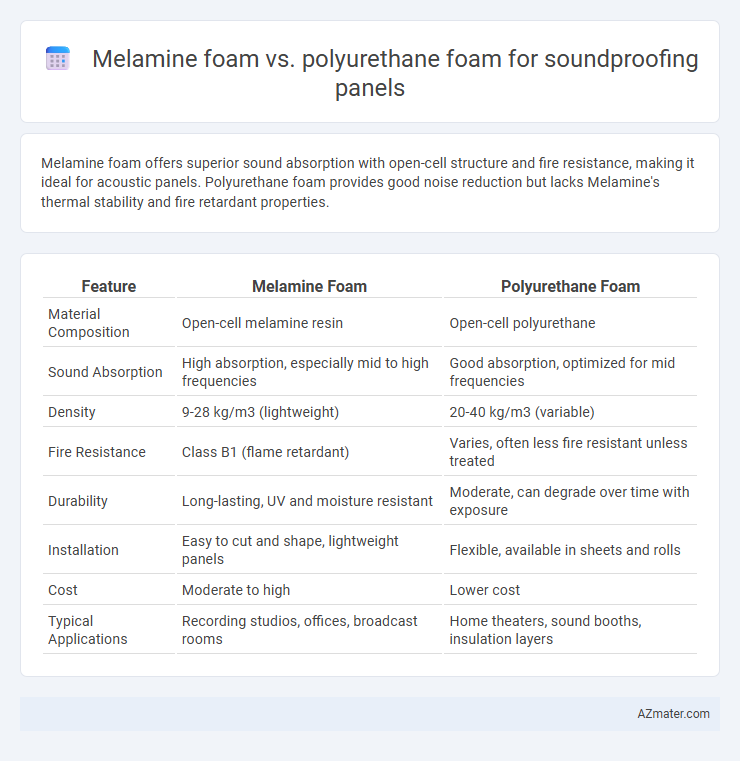Melamine foam offers superior sound absorption with open-cell structure and fire resistance, making it ideal for acoustic panels. Polyurethane foam provides good noise reduction but lacks Melamine's thermal stability and fire retardant properties.
Table of Comparison
| Feature | Melamine Foam | Polyurethane Foam |
|---|---|---|
| Material Composition | Open-cell melamine resin | Open-cell polyurethane |
| Sound Absorption | High absorption, especially mid to high frequencies | Good absorption, optimized for mid frequencies |
| Density | 9-28 kg/m3 (lightweight) | 20-40 kg/m3 (variable) |
| Fire Resistance | Class B1 (flame retardant) | Varies, often less fire resistant unless treated |
| Durability | Long-lasting, UV and moisture resistant | Moderate, can degrade over time with exposure |
| Installation | Easy to cut and shape, lightweight panels | Flexible, available in sheets and rolls |
| Cost | Moderate to high | Lower cost |
| Typical Applications | Recording studios, offices, broadcast rooms | Home theaters, sound booths, insulation layers |
Introduction to Soundproofing Panels
Soundproofing panels utilize materials like melamine foam and polyurethane foam to absorb and reduce noise effectively. Melamine foam is known for its open-cell structure, offering superior sound absorption and fire resistance, making it ideal for acoustic treatments. Polyurethane foam provides cost-effective soundproofing with moderate absorption qualities but typically lacks the fire retardancy and durability found in melamine foam.
What is Melamine Foam?
Melamine foam is a lightweight, open-cell material renowned for its excellent sound absorption properties, making it ideal for soundproofing panels. Its unique microstructure effectively traps sound waves, reducing echo and noise in various environments. Compared to polyurethane foam, melamine foam offers superior fire resistance and durability, enhancing both safety and longevity in acoustic treatments.
What is Polyurethane Foam?
Polyurethane foam is a versatile polymer material widely used for soundproofing panels due to its excellent noise absorption and cushioning properties. Its open-cell structure enables effective sound wave diffusion, reducing echo and reverberation in various environments. Compared to melamine foam, polyurethane foam offers a balance of affordability, durability, and acoustic performance suitable for both residential and commercial applications.
Acoustic Performance Comparison
Melamine foam offers superior sound absorption with its open-cell structure specifically engineered for high-frequency noise reduction, achieving Noise Reduction Coefficients (NRC) up to 0.85. Polyurethane foam, while effective, typically provides lower NRC values around 0.5 to 0.7 and performs better in mid-frequency ranges. Melamine foam panels also exhibit enhanced fire resistance and durability, making them a preferred choice for acoustic treatment in professional soundproofing applications.
Fire Resistance: Melamine vs Polyurethane
Melamine foam offers superior fire resistance compared to polyurethane foam, as it is inherently flame retardant and self-extinguishing, making it a safer choice for soundproofing panels in environments requiring strict fire safety standards. Polyurethane foam, although effective for acoustic insulation, is more flammable and tends to melt and produce toxic smoke when exposed to high temperatures. Building codes and safety regulations often favor melamine foam for applications where fire resistance is critical.
Durability and Longevity
Melamine foam outperforms polyurethane foam in durability and longevity for soundproofing panels due to its rigid, open-cell structure that resists compression and retains shape over time. Polyurethane foam tends to degrade faster under environmental stressors like moisture and UV exposure, leading to reduced acoustic performance. Melamine foam's inherent fire retardancy and chemical stability further enhance its lifespan, making it a superior choice for long-term soundproofing applications.
Environmental Impact and Safety
Melamine foam offers superior fire resistance and low toxicity compared to polyurethane foam, making it a safer choice for soundproofing panels in indoor environments. Polyurethane foam, while providing good acoustic insulation, often contains harmful flame retardants and emits volatile organic compounds (VOCs), raising environmental and health concerns. Melamine foam's non-halogenated composition and recyclability contribute to a lower environmental footprint, aligning with sustainable building practices.
Cost Effectiveness
Melamine foam offers superior cost-effectiveness compared to polyurethane foam for soundproofing panels due to its lightweight structure, higher noise absorption coefficients, and fire-resistant properties that reduce overall safety costs. Polyurethane foam, while generally less expensive upfront, tends to have lower durability and requires more frequent replacement, increasing long-term expenses. Melamine foam's balance of acoustic performance and longevity makes it a more economical choice in professional and residential soundproofing applications.
Best Applications for Each Foam
Melamine foam excels in sound absorption within high-frequency ranges, making it ideal for use in recording studios, broadcast booths, and office environments where echo reduction is critical. Polyurethane foam is better suited for low-frequency sound insulation and impact noise reduction, commonly applied in automotive cabins, home theaters, and industrial machinery enclosures. Selecting melamine foam benefits spaces requiring flame retardancy and lightweight properties, while polyurethane foam provides enhanced durability and cost-efficiency for broader acoustic treatments.
Choosing the Right Foam for Soundproofing Panels
Melamine foam offers superior sound absorption with its open-cell structure and high porosity, making it ideal for reducing echo and improving acoustic clarity in soundproofing panels. Polyurethane foam, while effective for general noise reduction, typically provides less efficiency in controlling mid to high-frequency sounds compared to melamine foam. Selecting the right foam depends on the specific acoustic requirements, with melamine foam favored for professional studios and environments demanding precise sound control.

Infographic: Melamine foam vs Polyurethane foam for Soundproofing panel
 azmater.com
azmater.com